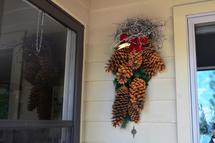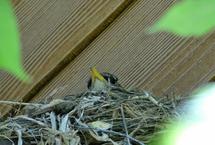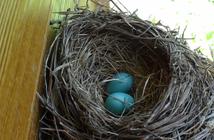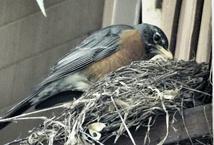saveourplanetearth.com
Call us: (775) 831-1331
Birds on the Deck
More than 700 bird species breed in North America. The nesting and breeding habits vary dramatically between the different species, yet some aspects are similar.
Birds undergo physiological changes as the days become longer, signaling the time to breed. Hormonal changes cause the internal testes of the male to swell to more than 1,000 times the normal size. In the female, the ovaries and oviduct also increase in size to prepare for egg fertilization and development.
After mating, the sperm travel to the oviduct where it can be stored until the egg is ready to be fertilized. The sperm penetrates the wall of the egg, and development begins. During the first stage, the shell forms.
Females typically produce one egg per day, as ovulation and laying take place over a 24-hour period. Some birds begin incubating as soon as the first egg is laid, resulting in staggered births. Others won’t incubate until all the eggs are laid, so that the eggs hatch at the same time.
There are several types of nests, ranging from a simple “scratch” in the ground layered with organic materials or sand, to elaborate platform nests, such as those of eagles and large birds of prey that take at least two weeks to construct, and are added to over a period of years.
Some birds build mounds of organic materials which function as natural compost heaps, generating heat as the materials rot.
Other birds dig horizontal tunnels into the face of a vertical wall of dirt. Others excavate cavities out of trees or rotting logs. Cavity nesters often will accept a man-made bird house in the proper location.
A common nest type, and that used by the American robin and Steller’s jays, is the cup nest.
The robin builds a nest constructed out of twigs, feathers and coarse grasses, which is then smeared with mud and cushioned with fine grasses and other soft materials. The female constructs the nest above ground in trees or bushes, but is not shy about building her nest close to humans on the rafters of homes or on deck railings, such as the nest built on the deck of Deirdre Kelly of Incline Village while she was out of town for two days.
The female robin will lay a clutch of three to five eggs, which are incubated continuously by the female. The eggs hatch after two weeks, the chicks fledging another two weeks later.
Both the male and female protect and feed the chicks after they leave the nest until they are able to forage on their own.
Robins will produce two to three clutches per season, building a new nest for each brood. Only 25% of the fledglings will survive through November.
Doris Spain of Incline Village was able to watch a family of Steller’s jays while sipping coffee from her kitchen table as they cleverly built a large nest outside her front door, on top of a sugar pine cone decoration she had hanging on the wall. The nest was built last year and presumably the same couple returned this spring to successfully raise two young.
The Steller’s jay nest is between 10 and 17 inches in diameter and 6 to 7 inches tall, built mainly of twigs, leaves and pine needles, cemented with mud, then lined with soft grasses or scavenged animal hair.
The male and female choose the nest site and gather nesting material together. The jay produces just one clutch per season, consisting of two to six eggs, typically two or three.
Doris is no stranger to bird watching. Years ago, when she lived in New Jersey with her husband and three young boys, her boys found a nest of three baby robins that had blown to the ground during a storm. The parents were not in evidence, so they carefully placed the nest in a box and brought it inside to a screened porch.
Unwilling to dig for worms every day, Doris fed them raw hamburger, which they devoured hungrily, taking water from an eye dropper.
The babies soon became strong enough to hop around and eventually fly, returning to roost on their porch at night. Doris knew that they could not live like that indefinitely, so the family took them to the Audubon Society Preserve 30 miles away and let the birds fly off to their destinies. Her children have never forgotten the experience, though it was over 40 years ago, and developed a love and respect for Nature and all of her creatures that have lasted throughout their lives.
Steller’s jay nest, built on the back porch at the home of Doris Spain
Photo courtesy of Doris Spain
Robin’s nest on the back deck of an Incline Village home, discovered after the residents were out of town for two days
Photo courtesy of Deirdre Kelly
Male American robin, tending to the chicks
Photo courtesy of Deirdre Kelly
Robin, incubating eggs, in a nest the pair built on a deck railing
Photo courtesy of Deirdre Kelly






